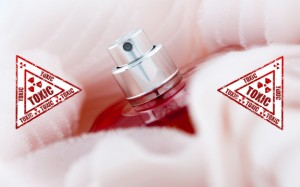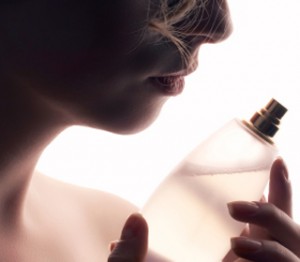AN INVESTIGATION OF CHEMICALS IN 36 EAUX DE TOILETTE AND EAUX DE PARFUM
FROM GREENPEACH.
 The goal of this investigation was to quantify the use of two groups of chemicals – phthalates and synthetic musks – in a random selection of perfume brands. Greenpeace commissioned a laboratory to test 36 brands of eau de toilette and eau de parfum for levels of the two chemical groups. The results confirm that some synthetic musks, most notably the polycyclic musks galaxolide (HHCB) and tonalide (AHTN), and some phthalates, especially diethyl phthalate (DEP), are widely used by the perfume industry. This suggests that regular use of perfumes could substantially contribute to individuals’ daily exposure to these chemicals, some of which have already been recorded as contaminants in blood and breast milk. Furthermore, there is increasing evidence of potential endocrine-disrupting properties for certain musk compounds. In this context, these results reinforce the need for legislation that will drive the replacement of hazardous substances with safer alternatives. The current development of new EU legislation on the manufacture and use of chemicals, known as REACH (Registration, Evaluation and Authorisation of Chemicals), provides the opportunity to set out requirements for such substitution as a vital contribution to protecting the public from exposure to hazardous chemicals.
The goal of this investigation was to quantify the use of two groups of chemicals – phthalates and synthetic musks – in a random selection of perfume brands. Greenpeace commissioned a laboratory to test 36 brands of eau de toilette and eau de parfum for levels of the two chemical groups. The results confirm that some synthetic musks, most notably the polycyclic musks galaxolide (HHCB) and tonalide (AHTN), and some phthalates, especially diethyl phthalate (DEP), are widely used by the perfume industry. This suggests that regular use of perfumes could substantially contribute to individuals’ daily exposure to these chemicals, some of which have already been recorded as contaminants in blood and breast milk. Furthermore, there is increasing evidence of potential endocrine-disrupting properties for certain musk compounds. In this context, these results reinforce the need for legislation that will drive the replacement of hazardous substances with safer alternatives. The current development of new EU legislation on the manufacture and use of chemicals, known as REACH (Registration, Evaluation and Authorisation of Chemicals), provides the opportunity to set out requirements for such substitution as a vital contribution to protecting the public from exposure to hazardous chemicals.
CHEMICALS IN PERFUMES: A HEALTH AND ENVIRONMENTAL CONCERN
Two groups of hazardous or potentially hazardous chemicals commonly used in perfumes and other personal care products are phthalate esters, commonly known as phthalates, and synthetic (artificial or man-made) musks. As a consequence of the extensive and high-volume use of these chemicals in products, they have become widely distributed through both the natural and the urban environment.The ubiquitous presence of synthetic musks and phthalates in the environment and in consumer products, many of which are very slow to break down, results in continuous background exposures with unknown long-term consequences. At the same time, personal care products that we apply to our skin, including perfumes, provide a direct route of repeated exposure to relatively concentrated doses and may be expected to contribute substantially to our overall exposure to these chemicals. Although data remain limited, there is evidence to suggest that the phthalates and synthetic musks in common use may present us with diverse health and environmental hazards. New evidence is emerging all the time. Further details of the properties and hazards of these chemicals are provided in the text boxes below.
ANALYSIS OF PERFUMES
 Between 2003 and 2004 Greenpeace commissioned the quantitative analysis of a random selection of 36 brands of eau de toilette and eau de parfum for phthalates, polycyclic musks and nitromusks. The independent Netherlands laboratory, TNO Environment and Geosciences, conducted the analyses (Peters, 2005) (http://www.greenpeace.org/tnoperfumereport). Detailed results of the analysis are shown in the annex of this report. The results show that phthalates and synthetic musks are present in virtually every perfume brand that was tested. All but one sample contained measurable levels of phthalates, with amounts varying enormously between brands. Only one had no detectable phthalate content. Several others had low levels of total phthalates, below 10 mg/kg (0.001%). By contrast, the sample with the highest level of phthalates contained over 22 000 mg/kg (2.2% of total sample by weight). The most prevalent phthalate was diethyl phthalate (DEP), found in 34 out of the 36 perfumes tested and with widely varying levels. Only Gloria Vanderbilt’s Vanderbilt and Bogner’s High Speed contained no detectable levels of this phthalate. The highest levels of DEP were found in Calvin Klein’s Eternity for Women (22 299 mg/kg, or 2.2% by weight), Melvita’s Iris Blue (11 189 mg/kg, or 1.1%) and Jean-Paul Gaultier’s Le Mâle (9 884 mg/kg, or just under 1%). The perfumes tested also showed wide variations in the quantities of synthetic musks that they contained. Total levels of nitromusks and polycyclic musks were lowest in Puma’s Puma Jamaica Man (0.1 mg/kg), Alqvimia’s Aqua Natural (0.5 mg/kg), Naomi Campbell’s Sunset (1.8 mg/kg) and Christian Dior’s Pure Poison (2 mg/kg). Highest total quantities of these synthetic musks were found in Cartier’s Le Baiser Du Dragon (45 048 mg/kg, or 4.5% by weight) and Gaultier’s Le Mâle (64 428 mg/kg, or 6.4%), and, with a remarkable 94 069 mg/kg (9.4%), The Body Shop’s White Musk.
Between 2003 and 2004 Greenpeace commissioned the quantitative analysis of a random selection of 36 brands of eau de toilette and eau de parfum for phthalates, polycyclic musks and nitromusks. The independent Netherlands laboratory, TNO Environment and Geosciences, conducted the analyses (Peters, 2005) (http://www.greenpeace.org/tnoperfumereport). Detailed results of the analysis are shown in the annex of this report. The results show that phthalates and synthetic musks are present in virtually every perfume brand that was tested. All but one sample contained measurable levels of phthalates, with amounts varying enormously between brands. Only one had no detectable phthalate content. Several others had low levels of total phthalates, below 10 mg/kg (0.001%). By contrast, the sample with the highest level of phthalates contained over 22 000 mg/kg (2.2% of total sample by weight). The most prevalent phthalate was diethyl phthalate (DEP), found in 34 out of the 36 perfumes tested and with widely varying levels. Only Gloria Vanderbilt’s Vanderbilt and Bogner’s High Speed contained no detectable levels of this phthalate. The highest levels of DEP were found in Calvin Klein’s Eternity for Women (22 299 mg/kg, or 2.2% by weight), Melvita’s Iris Blue (11 189 mg/kg, or 1.1%) and Jean-Paul Gaultier’s Le Mâle (9 884 mg/kg, or just under 1%). The perfumes tested also showed wide variations in the quantities of synthetic musks that they contained. Total levels of nitromusks and polycyclic musks were lowest in Puma’s Puma Jamaica Man (0.1 mg/kg), Alqvimia’s Aqua Natural (0.5 mg/kg), Naomi Campbell’s Sunset (1.8 mg/kg) and Christian Dior’s Pure Poison (2 mg/kg). Highest total quantities of these synthetic musks were found in Cartier’s Le Baiser Du Dragon (45 048 mg/kg, or 4.5% by weight) and Gaultier’s Le Mâle (64 428 mg/kg, or 6.4%), and, with a remarkable 94 069 mg/kg (9.4%), The Body Shop’s White Musk.
